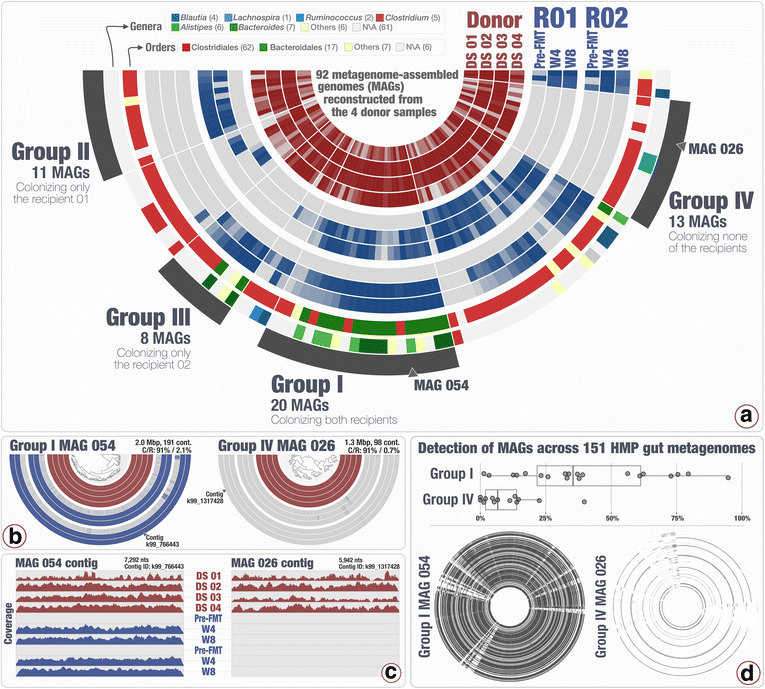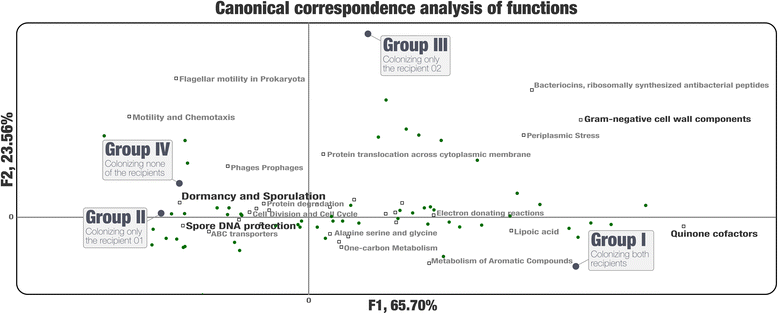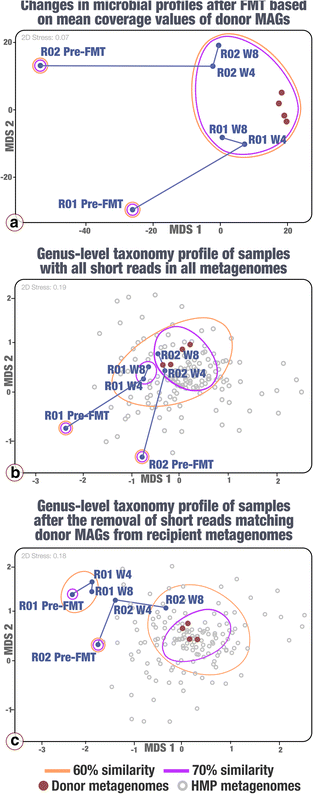Tracking microbial colonization in fecal microbiota transplantation experiments via genome-resolved metagenomics
- PMID: 28473000
- PMCID: PMC5418705
- DOI: 10.1186/s40168-017-0270-x
Tracking microbial colonization in fecal microbiota transplantation experiments via genome-resolved metagenomics
Abstract
Background: Fecal microbiota transplantation (FMT) is an effective treatment for recurrent Clostridium difficile infection and shows promise for treating other medical conditions associated with intestinal dysbioses. However, we lack a sufficient understanding of which microbial populations successfully colonize the recipient gut, and the widely used approaches to study the microbial ecology of FMT experiments fail to provide enough resolution to identify populations that are likely responsible for FMT-derived benefits.
Methods: We used shotgun metagenomics together with assembly and binning strategies to reconstruct metagenome-assembled genomes (MAGs) from fecal samples of a single FMT donor. We then used metagenomic mapping to track the occurrence and distribution patterns of donor MAGs in two FMT recipients.
Results: Our analyses revealed that 22% of the 92 highly complete bacterial MAGs that we identified from the donor successfully colonized and remained abundant in two recipients for at least 8 weeks. Most MAGs with a high colonization rate belonged to the order Bacteroidales. The vast majority of those that lacked evidence of colonization belonged to the order Clostridiales, and colonization success was negatively correlated with the number of genes related to sporulation. Our analysis of 151 publicly available gut metagenomes showed that the donor MAGs that colonized both recipients were prevalent, and the ones that colonized neither were rare across the participants of the Human Microbiome Project. Although our dataset showed a link between taxonomy and the colonization ability of a given MAG, we also identified MAGs that belong to the same taxon with different colonization properties, highlighting the importance of an appropriate level of resolution to explore the functional basis of colonization and to identify targets for cultivation, hypothesis generation, and testing in model systems.
Conclusions: The analytical strategy adopted in our study can provide genomic insights into bacterial populations that may be critical to the efficacy of FMT due to their success in gut colonization and metabolic properties, and guide cultivation efforts to investigate mechanistic underpinnings of this procedure beyond associations.
Keywords: Colonization; Fecal microbiota transplantation; Metagenome-assembled genomes; Metagenomics.
Figures



Similar articles
-
Colonization potential to reconstitute a microbe community in patients detected early after fecal microbe transplant for recurrent C. difficile.BMC Microbiol. 2016 Jan 13;16:5. doi: 10.1186/s12866-015-0622-2. BMC Microbiol. 2016. PMID: 26758906 Free PMC article. Clinical Trial.
-
Changes in microbial ecology after fecal microbiota transplantation for recurrent C. difficile infection affected by underlying inflammatory bowel disease.Microbiome. 2017 May 15;5(1):55. doi: 10.1186/s40168-017-0269-3. Microbiome. 2017. PMID: 28506317 Free PMC article.
-
Recovery of the gut microbiome following fecal microbiota transplantation.mBio. 2014 Jun 17;5(3):e00893-14. doi: 10.1128/mBio.00893-14. mBio. 2014. PMID: 24939885 Free PMC article. Clinical Trial.
-
The Super-Donor Phenomenon in Fecal Microbiota Transplantation.Front Cell Infect Microbiol. 2019 Jan 21;9:2. doi: 10.3389/fcimb.2019.00002. eCollection 2019. Front Cell Infect Microbiol. 2019. PMID: 30719428 Free PMC article. Review.
-
Laboratory Testing of Donors and Stool Samples for Fecal Microbiota Transplantation for Recurrent Clostridium difficile Infection.J Clin Microbiol. 2017 Apr;55(4):1002-1010. doi: 10.1128/JCM.02327-16. Epub 2017 Jan 11. J Clin Microbiol. 2017. PMID: 28077694 Free PMC article. Review.
Cited by
-
Profiling a Community-Specific Function Landscape for Bacterial Peptides Through Protein-Level Meta-Assembly and Machine Learning.Front Genet. 2022 Jul 22;13:935351. doi: 10.3389/fgene.2022.935351. eCollection 2022. Front Genet. 2022. PMID: 35938008 Free PMC article.
-
Estimating relative biomasses of organisms in microbiota using "phylopeptidomics".Microbiome. 2020 Mar 6;8(1):30. doi: 10.1186/s40168-020-00797-x. Microbiome. 2020. PMID: 32143687 Free PMC article.
-
Separation of Donor and Recipient Microbial Diversity Allows Determination of Taxonomic and Functional Features of Gut Microbiota Restructuring following Fecal Transplantation.mSystems. 2021 Aug 31;6(4):e0081121. doi: 10.1128/mSystems.00811-21. Epub 2021 Aug 17. mSystems. 2021. PMID: 34402648 Free PMC article.
-
Single-colony sequencing reveals microbe-by-microbiome phylosymbiosis between the cyanobacterium Microcystis and its associated bacteria.Microbiome. 2021 Sep 27;9(1):194. doi: 10.1186/s40168-021-01140-8. Microbiome. 2021. PMID: 34579777 Free PMC article.
-
Drivers and determinants of strain dynamics following fecal microbiota transplantation.Nat Med. 2022 Sep;28(9):1902-1912. doi: 10.1038/s41591-022-01913-0. Epub 2022 Sep 15. Nat Med. 2022. PMID: 36109636 Free PMC article.
References
Publication types
MeSH terms
Substances
Associated data
Grants and funding
LinkOut - more resources
Full Text Sources
Other Literature Sources
Research Materials

